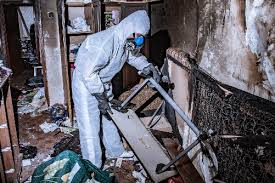Introduction: Understanding Mold and Why It’s a Problem
Mold removal and remediation is more than an unsightly nuisance—it’s a serious health hazard and structural threat. Mold growth, triggered by moisture, can spread rapidly through homes, offices, and commercial buildings. If left untreated, mold can cause respiratory issues, structural damage, and costly repairs.
What is Mold?
Mold is a type of fungus that thrives in damp, warm, and humid environments. It reproduces through microscopic spores that float through the air, making it easy to spread and hard to eliminate once established.
Common Types of Mold in Homes
-
Cladosporium – Often found on wood and fabrics.
-
Penicillium – Known for rapid growth on materials like wallpaper and insulation.
-
Stachybotrys chartarum (Black Mold) – Toxic mold that poses serious health risks.
Signs You Have a Mold Problem
-
Musty or earthy smell
-
Discoloration on walls, ceilings, or floors
-
Peeling paint or wallpaper
-
Water damage or leaks
-
Persistent coughing or allergy symptoms indoors
Health Risks of Mold Exposure
Exposure to mold can lead to a variety of health issues, particularly for those with allergies, asthma, or weakened immune systems.
Common Health Effects
-
Coughing and sneezing
-
Skin rashes
-
Eye irritation
-
Nasal congestion
-
Fatigue and headaches
-
In severe cases: respiratory infections or asthma attacks
What Causes Mold Growth?
Understanding the causes is essential for effective mold prevention.
Common Causes Include:
-
Leaky roofs or pipes
-
Poor ventilation
-
High indoor humidity
-
Flood damage
-
Wet or damp basements
The Mold Remediation Process: Step-by-Step
Professional mold remediation involves much more than just scrubbing surfaces. Here’s how experts typically tackle mold issues:
1. Inspection and Assessment
Certified professionals assess the extent of mold damage using moisture meters and air quality testing.
2. Containment
To prevent spores from spreading, areas are sealed using plastic sheeting and negative air pressure machines.
3. Air Filtration
HEPA air scrubbers and filters are used to clean airborne spores.
4. Mold Removal
Affected materials like drywall, insulation, and carpeting may be removed. Non-porous surfaces are scrubbed and treated with antimicrobial solutions.
5. Cleaning and Sanitizing
Thorough cleaning includes disinfecting personal belongings, furniture, and the surrounding area.
6. Restoration
Replacing drywall, painting, or even reconstructing areas as needed to restore the space to its original condition.
DIY Mold Removal: When is it Safe?
Small mold patches (under 10 sq ft) may be safe for DIY removal. However, black mold or widespread infestations should always be handled by professionals.
DIY Tips:
-
Wear N95 mask and gloves
-
Use mold-killing cleaners like vinegar or hydrogen peroxide
-
Ensure proper ventilation
-
Never mix bleach with ammonia
Why You Should Hire a Professional Mold Remediation Company
Advantages of Hiring Experts:
-
Accurate assessment using thermal imaging and moisture detection tools
-
Safe handling of toxic mold (e.g., Stachybotrys)
-
Prevention of cross-contamination
-
Long-term solutions to prevent recurrence
How Much Does Mold Remediation Cost?
Average Costs:
-
Small area: $500 – $1,500
-
Medium area: $2,000 – $5,000
-
Severe infestation: $6,000 – $10,000+
Costs vary based on the size of the affected area, the type of mold, and the extent of damage.
Preventing Mold After Remediation
Preventing mold is all about controlling moisture.
Prevention Tips:
-
Fix leaks immediately
-
Use dehumidifiers in damp areas
-
Improve airflow with fans and exhaust vents
-
Regularly inspect HVAC systems
-
Clean gutters and downspouts
Mold in Commercial Buildings
Mold in offices, schools, and commercial spaces poses risks to both property and personnel. Business owners are legally obligated to maintain safe indoor air quality.
Legal and Insurance Considerations
Insurance:
Some homeowner policies cover mold removal if caused by a covered peril (e.g., pipe burst). Always check your policy details.
Legal:
Landlords may be liable if mold results from negligence or lack of maintenance.
Why You Should Hire a Professional Mold Remediation Company
Advantages of Hiring Experts:
-
Accurate assessment using thermal imaging and moisture detection tools
-
Safe handling of toxic mold (e.g., Stachybotrys)
-
Prevention of cross-contamination
-
Long-term solutions to prevent recurrence
How Much Does Mold Remediation Cost?
Average Costs:
-
Small area: $500 – $1,500
-
Medium area: $2,000 – $5,000
-
Severe infestation: $6,000 – $10,000+
Costs vary based on the size of the affected area, the type of mold, and the extent of damage.
Preventing Mold After Remediation
Preventing mold is all about controlling moisture.
Prevention Tips:
-
Fix leaks immediately
-
Use dehumidifiers in damp areas
-
Improve airflow with fans and exhaust vents
-
Regularly inspect HVAC systems
-
Clean gutters and downspouts
Mold in Commercial Buildings
Mold in offices, schools, and commercial spaces poses risks to both property and personnel. Business owners are legally obligated to maintain safe indoor air quality.
Legal and Insurance Considerations
Insurance:
Some homeowner policies cover mold removal if caused by a covered peril (e.g., pipe burst). Always check your policy details.
Legal:
Landlords may be liable if mold results from negligence or lack of maintenance.
Frequently Asked Questions (FAQs)
Q: Is mold dangerous to pets?
Yes. Pets can suffer from similar respiratory issues as humans due to mold exposure.
Q: How long does mold remediation take?
Typically, 1–5 days depending on severity.
Q: Will mold come back after removal?
It shouldn’t—if moisture issues are properly addressed.
Q: Is bleach effective on mold?
Only on non-porous surfaces. For porous materials, professional-grade products are more effective.
Final Thoughts: Take Action Early
Mold remediation is not just about removing visible growth—it’s about safeguarding your health and protecting your property. Whether you’re dealing with a small patch or a large-scale infestation, early action is the key to effective mold control.
Need Help? Call a Certified Mold Removal Specialist Near You
If you’re noticing signs of mold or have had recent water damage, don’t wait. Contact a local, certified mold remediation expert to inspect and restore your home safely and effectively.



